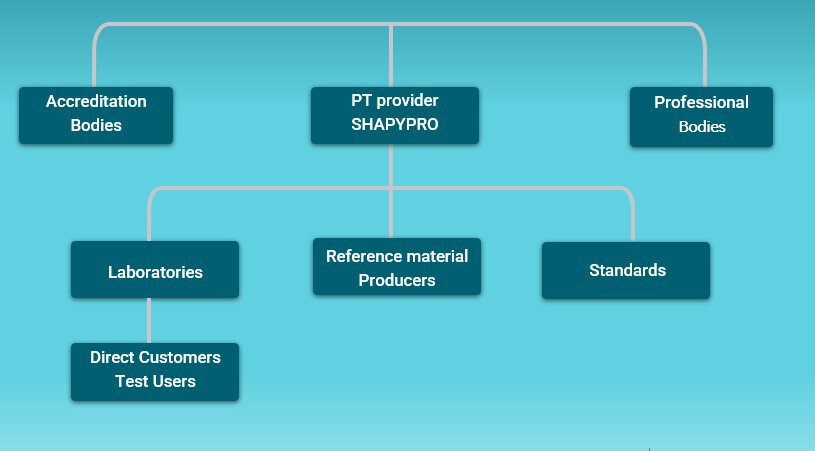While some laboratories may view participation in proficiency testing (PT) programs as a necessity to satisfy accreditation bodies, they could be overlooking the more fundamental benefits that can be achieved by taking part in well-designed PT programs.
Clearly, laboratories are the major stakeholders in PT program participation, but there may be other stakeholders, who also have a major interest in such programs and in the performance of laboratories involved.
The figure below illustrates the various parties who may have an interest in PT programs. However, it is the intention of this short paper to highlight the potential benefits for laboratories.

Participation Benefits
The following are some of the potential benefits which may be available to participating laboratories:
- Confirming competent performance.
- Identifying testing or measurement problems.
- Comparing methods and procedures.
- Improving performance.
- Educating staff.
- Instilling confidence in staff, management and external users of laboratory services.
- Comparing operator capabilities.
- Generating reference materials.
- Determining method precision and accuracy.
- Satisfying regulators and accreditation bodies.
- Providing laboratories with additional risk management.
While not all of the above will be relevant for individual PT programs, some of the above benefits will be ongoing benefits available to participants from program to program.
Technical Competence Demonstration
The basic purpose of proficiency testing is to assess the performance of laboratories for their conduct of specific test, measurements or calibrations. Many laboratories operate in isolation from other laboratories and do not have ongoing opportunities to compare their data with others. Without such opportunities there are risks that a laboratory’s data may have errors, biases or significant differences compared to similar laboratories.
Proficiency testing provides an opportunity to undertake such comparisons and to have an independent appraisal of the laboratory’s data compared to reference values (or other performance criteria) or to the performance of similar laboratories. The results from such participation provide laboratory managers with either a confirmation that the laboratory’s performance is satisfactory or an alert that an investigation of potential problems within the
laboratory is required.
Identifying Testing or Measurement Problems
If a laboratory’s results in a proficiency testing program indicate that its data is not comparable to reference values or other performance criteria, the resulting investigation offers an opportunity for the laboratory to identify potential sources of error or the circumstances that precipitated the unsatisfactory performance.
Without participation in the proficiency testing program, such sources of error could remain undetected and the laboratory would not have been able to undertake appropriate corrective actions. This, in turn, could have resulted in the laboratory continuing to provide poor results to its clients or other stakeholders. Eventually, such errors could also lead to the loss of reputation of the laboratory or to legal or other action being taken by the clients or other stakeholders, such as regulatory bodies. In this regard the use of proficiency testing may be considered to be a risk management and quality improvement tool.
Comparing Methods or Procedures
For some laboratories, their participation might be used to trial their performance using a new or irregularly conducted test or measurement. In other cases, the participation may provide an opportunity to compare the results achieved by the laboratory using different methods (or different concentration levels etc) to those normally used by the laboratory.
The program itself might, in some cases, provide summaries and comparisons of all laboratories’ methods. For new or unusual activities, such data could be most valuable and assist the future selection of appropriate methodology by the laboratory or indicate the need for additional investigation before adoption of new methods.
Improving Performance
When a laboratory is not satisfied with its own results in a proficiency testing program, this provides an opportunity for the laboratory’s management to investigate areas where its future testing could be improved. This might, for example, include additional operator training, adoption of new or modified methods, enhancing internal quality control of data, equipment modifications, calibration or replacement etc.
Staff Training Plans
Many proficiency testing programs have, as one of their objectives, provision of information on methodology, data interpretation, uncertainty assignments etc which arise from the overall results in the program, or which are provided by experts involved in evaluating such results. Some programs have a comprehensive educational role for participants and individual operators.
Confidence
Successful performance in a proficiency test can provide individual staff and their direct managers with additional confidence. Other management, including those without relevant technical expertise, can also be re-assured by their laboratory’s staff successful performance, often in areas of critical significance to their organization’s activities and responsibilities.
Laboratory’s client services, including their clients and the parties affected by the outcomes of testing, can also be given added confidence when made aware that a laboratory is willing to have its testing or measurement performance regularly evaluated through proficiency testing.
Operator Capabilities Comparison
When sufficient test material (or access to measurement) is available to more than one operator within a participating laboratory, the laboratory has the added benefit of being able to compare the results of its operators on test materials which are also being tested or measured by other external laboratories. This can assist the laboratory to not only compare the performance of its own operators, but might also provide some inputs to the laboratory’s estimates of its measurement uncertainty for the relevant tests.
This might also allow the laboratory to evaluate the between-operator repeatability achieved by the laboratory compared to published (or otherwise available) data for the test methods concerned.
Precision and Accuracy determination
Depending on the design of the proficiency test, some programs will be useful in determining the precision (repeatability and reproducibility) or comparative accuracy of the methods used in the program.
Regulatory Accreditation Satisfaction
Finally, the successful performance of a laboratory in a proficiency test (or its effective correction of testing problems after an unsuccessful performance) may provide regulators and accreditation bodies with confidence in the laboratories whose data they endorse or otherwise recognize. The clear benefit for the laboratories is the continuation of their standing as competent organizations.
However, the internal benefits to laboratories, their staff and management (as discussed in this paper), should be of most value if they view proficiency testing as a vital tool for ongoing maintenance of confidence and improvement, irrespective of whether or not the laboratory needs to participate for accreditation purposes.
Follow us LinkedIn-shapypro
If you would like to know more about the benefits of participating in our programs, please contact us at:
📧 info@shapypro.com
☎ + 34 633 596 678
Image source: http://storyset.com


